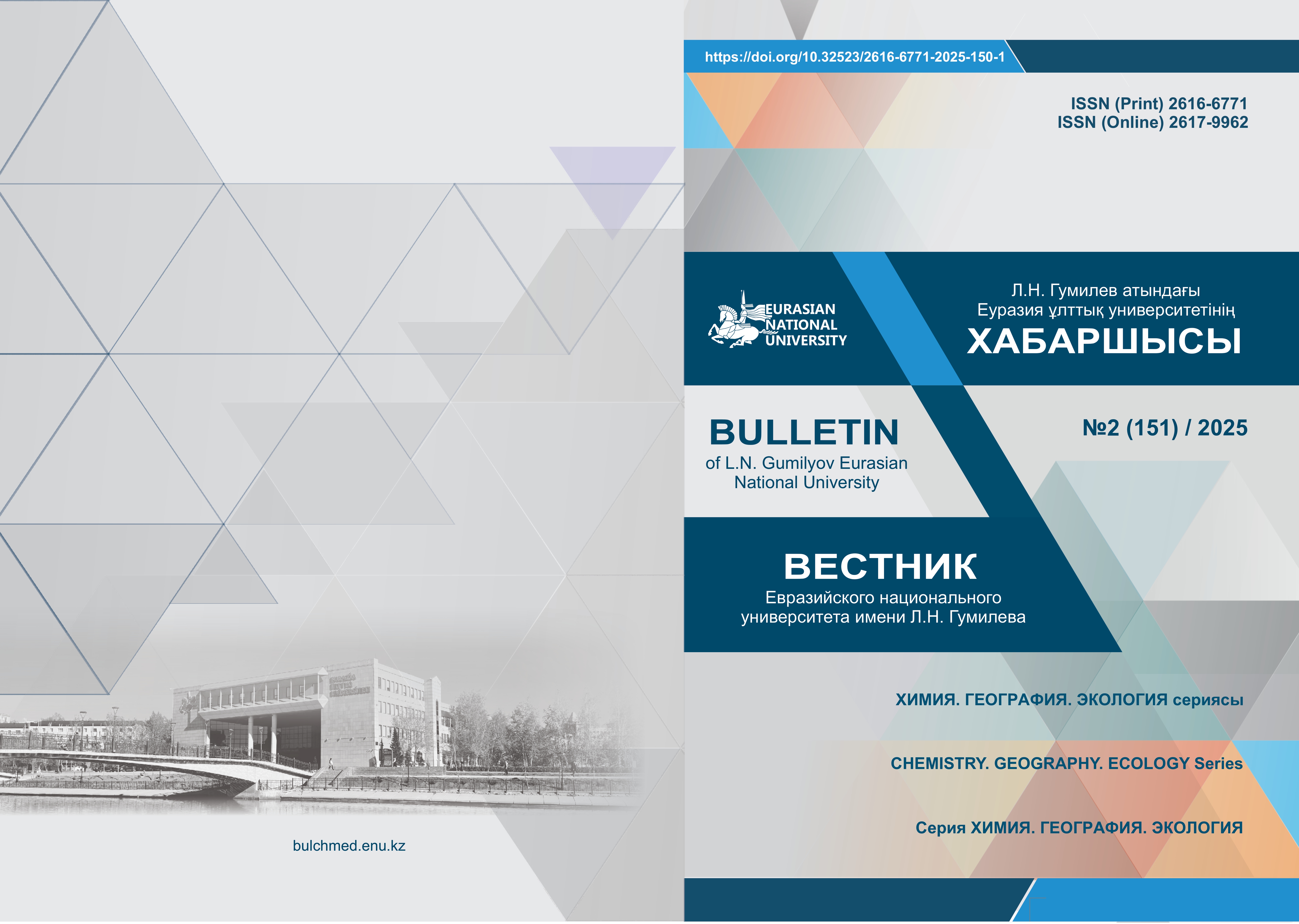Университет кампустарында төмен көміртекті су ресурстарын басқару және қайта пайдалану жөніндегі экологиялық бағалау: жаһандық көзқарас
Қаралымдар: 1260 / PDF жүктеулері: 314
DOI:
https://doi.org/10.32523/2616-6771-2025-151-2-270-293Кілт сөздер:
төмен көміртекті суды басқару, ағынды суларды қайта өңдеу, экологиялық бағалау, тұрақты су ресурстары, университет кампусыАңдатпа
Әлемдегі университеттер су тапшылығы мәселесінің күшеюіне тап болып отыр, сондықтан суды басқарудың инновациялық төмен көміртекті стратегиялары енгізілуде. Осы зерттеуде 12 елден алынған 27 тақырыптық зерттеудің синтезіне негізделген университет кампустарында төмен көміртекті су пайдалану мен рециркуляцияның жаһандық экологиялық талдауы ұсынылған. Жиналған деректерде тазарту технологиялары (биологиялық, мембраналық, физика-химиялық және гибридтік жүйелер), сапа көрсеткіштері (BOD, TSS, TDS), қайта пайдалану көрсеткіштері және экономикалық параметрлер (қаржылық шығындар мен инвестицияның қайтарым мерзімі) қамтылған. Сипаттамалық статистика бойынша кампустарда суды рециркуляциялау орташа деңгейі 57% (медианалық мәні – 33%), ал биологиялық процестер органикалық ластаушыларды (BOD) 95%-ға дейін жояды, бірақ еріген заттар (TDS) мөлшерін азайту үшін көбіне үшінші реттік тазалауды талап етеді. Қаржылық шығындар 15 000–157 000 АҚШ долларына дейін ауытқып, инвестицияның өзін-өзі ақтау мерзімі 3-тен 6,5 жылға дейінгі аралықты құрады. SWOT-талдау – TDS-ті жеткіліксіз жою, реттеудегі олқылықтар, әлеуметтік қарсылық және мүмкіндіктер, атап айтқанда ESG-қаржыландырудың өсуі, ағартушылық қызмет және автономды жүйелерді дамыту сынды негізгі кедергілерді анықтады. Нәтижелер университет кампустарының тұрақты су стратегиялары үшін «тірі зертхана» ретіндегі шешуші рөлін айқындайды, кампус деңгейіндегі рециркуляция 6-шы ТДМ (Тұрақты даму мақсаттары) – «Таза су және санитария» мақсатына қол жеткізуге ықпал ететінін дәлелдейді, алайда бұл үшін стандартталған өмірлік циклді бағалауды, жергілікті нормативтік және климаттық жағдайларға бейімделуді талап етеді. Сонымен қатар, бұл зерттеу өмірлік циклді сенімді бағалауды және көміртек шығарындыларын толық есепке алудың маңыздылығын көрсетеді.
Downloads
Әдебиеттер тізімі
Maawali, F.A.S., Al-Sheidi, R.S.A.S., Al Risi, M.S.N., Al Balushi, F.A.M., Shahulhameed, B. (2020). Innovations in the design of sewage treatment plants-A review. Journal of Student Research, 1-6. https://doi.org/10.47611/jsr.vi.930
Albalawneh, A., Chang, T.-K. (2015). Review of the greywater and proposed greywater recycling scheme for agricultural irrigation reuses. International Journal of Research-Granthaalayah, 3(12), 16-35. https://doi.org/10.29121/granthaalayah.v3.i12.2015.2882
Al-Dmour, H. (2023). Green-smart university campuses: The mediating role of student engagement in enhancing corporate image. SAGE Open, 13(4), 1-17. https://doi/org/10.1177/21582440231219591
Ariff, S., Rizwan, A., Akshaya, K., Manikanta, T. (2021). Design of sewage treatment plant for Dr. TTIT campus. Proceedings of the First International Conference on Advanced Scientific Innovation in Science, Engineering and Technology (ICASISET 2020), 1-6. https://doi.org/10.4108/eai.16-5-2020.2304027
Ashkanani, A., Almomani, F., Khraisheh, M., Bhosale, R., Tawalbeh, M., Aljaml, K. (2019). Bio-carrier and operating temperature effect on ammonia removal from secondary wastewater effluents using moving bed biofilm reactor (MBBR). Science of the Total Environment, 693, 133425, 1-10. https://doi.org/10.1016/j.scitotenv.2019.07.231
Aslam, Z., Alam, P., Islam, R., Khan, A.H., Samaraweera, H., Hussain, A., Zargar, T.I. (2025). Recent developments in moving bed biofilm reactor (MBBR) for the treatment of phenolic wastewater: A review. Journal of the Taiwan Institute of Chemical Engineers, 166(2), 105517-105530. https://doi.org/10.1016/j.jtice.2024.105517
Awasthi, A., Gandhi, K., Rayalu, S. (2024). Greywater treatment technologies: A comprehensive review. International Journal of Environmental Science and Technology, 21(1), 1053–1082. https://doi.org/10.1007/s13762-023-04940-7
Bari, M.N. (2019). Development of treatment unit for the treatment of municipal wastewater of Rajshahi City. Trends in Civil Engineering and Its Architecture, 3(3), 422-429. https://doi.org/10.32474/tceia.2019.03.000163
Bhagat, S.K., Tiyasha (2013). Assessment of efficiency of the sewage treatment plant at Sri Balaji Technical Campus. International Journal of Scientific Research and Reviews, 2(1), 115–125. https://doi.org/10.3126/KUSET.V6I2.4020
Bhar Gavi, M., Rao, E.A., Llika, T.P., Teja, Y.S. (2018). Analysis and design of sewage treatment plant: A case study on Vizianagaram Municipality. International Journal of Civil Engineering, 5(4), 24–28. https://doi.org/10.14445/23488352/IJCE-V5I4P105
Bharath Kumar, R.B., Nagarajappa, D.P., Shamsundar, K.M., Shivakeshava Kumar, P. (2014). Proposed wastewater treatment plant design of Harihar City. International Journal of Engineering Research & Technology, 3(9), 553-559.
Biswas, A., Bali, A.S., Dhiren, T., Ronak, Z., Bhavin, B. (2018). Study and modification of sewage treatment plant at Jaspur. IJIRST –International Journal for Innovative Research in Science & Technology, 4(10), 118-123.
Blodau, C. (2006). A review of acidity generation and consumption in acidic coal mine lakes and their watersheds. Science of the Total Environment, 369, 307–332. https://doi.org/10.1016/j.scitotenv.2006.05.004
Boddu S.R., Manga V.A. (2018). Characterization of sewage and design of sewage treatment plant for a Anakapalle town. International Journal of Management, Technology And Engineering, 8(12), 5299-5304. https://doi.org/10089.IJMTE.2018.V8I12.17.2599
Bognár, S., Putnik, P., Šojić Merkulov, D. (2022). Sustainable green nanotechnologies for innovative purifications of water: Synthesis of the nanoparticles from renewable sources. Nanomaterials, 12 (2), 1-32. https://doi.org/10.3390/nano12020263
Bojkova, T.E., Bogdanovich, N.I., Kanarskij, A.V., Kanarskaya, I.Z.A. (2020). Sovremennye flokulyanty na osnove poliakrilamida i alginata natriya v protsessakh vodopodgotovki [Modern flocculants based on polyacrylamide and sodium alginate in water treatment processes]. Vestnik Tekhnologicheskogo Universiteta [Herald of technological university], 22 (2). 53-57.
Choudhary, A.P., Pandey, G. (2014). Design and operational aspects of common effluent treatment plant in GIDA project area of Gorakhpur (U.P.). International Journal of Engineering Sciences & Research Technology, 3(3), 1815-1821.
Adama Science and Technology University, Civil Engineering Department, Group 13814. (2015). Sewage treatment design for Adama Science and Technology University. The Ethiopian Journal of Sciences and Sustainable Development Adama Science& Technology University (ASTU), 3(3), 1-30.
Dezotti, M., Lippel, G., Bassin, J.P. (2018). Advanced biological processes for wastewater treatment. Cham: Springer International Publishing. https://doi.org/10.1007/978-3-319-58835-3
Di Trapani, D., Mannina, G., Torregrossa, M., Viviani, G. (2008). Hybrid moving bed biofilm reactors: A pilot plant experiment. Water Science and Technology, 57, 1539–1545. https://doi.org/10.2166/wst.2008.219
Gehrke, I., Geiser, A., Somborn-Schulz, A. (2015). Innovations in nanotechnology for water treatment. Nanotechnology, Science and Applications, 8, 1–17. https://doi.org/10.2147/NSA.S43773
Ghaitidak, D.M., Yadav, K.D. (2013). Characteristics and treatment of greywater: A review. Environmental Science and Pollution Research, 20(5), 2795–2809. https://doi.org/10.1007/s11356-013-1533-0
Ghawi, A. (2018). Study on the development of household wastewater treatment unit. Journal of Ecological Engineering, 19(2), 63–71. https://doi.org/10.12911/22998993/81780
Gherheș, V., Cernicova-Buca, M. (2025). Reducing water consumption on a student campus through communication campaigns. Sustainability, 17(2), 1-14. https://doi.org/10.3390/su17020680
Iorhemen, O., Hamza, R., Tay, J. (2016). Membrane bioreactor (MBR) technology for wastewater treatment and reclamation: Membrane fouling. Membranes, 6(33). 1-29. https://doi.org/10.3390/membranes6020033
Iyer, V.G. (2017). Design and development of sustainable wastewater treatment plant for sustainable development management of wastewater. Management of Wastewater, 5(5), 486–492. https://doi.org/10.17265/2328-7144/2017.05.011
Jadhao, A.V.P., Ahire, P.N., Bankar, S.B., Chavhan, T.M., Nagargoje, A.S., Birhade, P.M. (2023). The comparative study of waste water and purified water present in sewage treatment plant in Bhusawal City. International Research Journal of Engineering and Technology (IRJET), 10(4). 65-69.
Jiang, D., Matsushita, B., Pahlevan, N., Gurlin, D., Lehmann, M.K., Fichot, C.G., Schalles, J. (2021). Remotely estimating total suspended solids concentration in clear to extremely turbid waters using a novel semi-analytical method. Remote Sensing of Environment, 258(1). https://doi.org/10.1016/j.rse.2021.112386
Kalmegh, A.S., Mohite, D.R., Lokhande, P.S. (2019). Experimental analysis of wastewater in Shahu campus of Pune City. International Research Journal of Engineering and Technology (IRJET), 06(1), 1771-1774.
Kanwar, R.M.A., Khan, Z.M., Farid, H.U. (2019). Development and adoption of wastewater treatment system for peri-urban agriculture in Multan, Pakistan. Water Science and Technology, 80(8), 1524–1537. https://doi.org/10.2166/wst.2019.403
Kumar, P. (2020). Design of sewage treatment plant for small town. International Journal for Research in Applied Science and Engineering Technology, 8, 2177–2183. https://doi.org/10.22214/ijraset.2020.5358
Kumar, S., Kumar, S. (2022). Performance evaluation of sewage treatment plant in Kanpur City. International Research Journal of Engineering and Technology (IRJET), 9(11), 97–104.
Kumdokrub, T., Carson, S., You, F. (2023). Cornell University campus metabolism and circular economy using a living laboratory approach to study major resource and material flows. Journal of Cleaner Production, 421 (1), 138469. https://doi.org/10.1016/j.jclepro.2023.138469
Leiknes, T., Ødegaard, H. (2007). The development of a biofilm membrane bioreactor. Desalination, 202(3), 135-143. https://doi.org/10.1016/j.desal.2005.12.049
Li, F., Wichmann, K., Otterpohl, R. (2009). Evaluation of appropriate technologies for grey water treatments and reuses. Water Science and Technology, 59, 249–260. https://doi.org/10.2166/wst.2009.854
Li, J., Li, Y., Xiong, Z., Yao, G., Lai, B. (2019). The electrochemical advanced oxidation processes coupling of oxidants for organic pollutants degradation: A mini-review. Chinese Chemical Letters, 30, 2139–2146. https://doi.org/10.1016/j.cclet.2019.04.057
Lindmark, M., Cherukumilli, K., Crider, Y.S., Marcenac, P., Lozier, M., Voth-Gaeddert, L., Lantagne, D.S. (2022). Passive in-line chlorination for drinking water disinfection: A critical review. Environmental Science & Technology, 56(13), 9164–9181. https://doi.org/10.1021/acs.est.1c08580
Mekonnen, M.M., Hoekstra, A.Y. (2016). Four billion people facing severe water scarcity. Science Advances, 2(2), 1-6. https://doi.org/10.1126/sciadv.1500323
Michałowski, T., Asuero, A.G. (2012). New approaches in modeling carbonate alkalinity and total alkalinity. Critical Reviews in Analytical Chemistry, 42(3), 220–244. https://doi.org/10.1080/10408347.2012.660067
Motaghed, S., Hassni, A.H., Mirzahosseini, S.A.H. (2024). Comparative study of biotreated leachate before and after using AOPs treatment for removing COD, BOD and color. Journal Of Gas Technology, 9 (1), 34-49. https://doi.org/20.1001.1/jgt.2024.2036910.1044
Nishu, Kumar, S. (2023). Smart and innovative nanotechnology applications for water purification. Hybrid Advances, 3, 100044. https://doi.org/10.1016/j.hybadv.2023.100044
Olanrewaju, O., Ilemobade, A. (2015). Greywater reuse review and framework for assessing greywater treatment technologies for toilet flushing. Advances in Research, 5, 1–25. https://doi.org/10.9734/AIR/2015/19117
Palya, R., Sinha, V.K. (2018). Design of a sewage treatment plant for a locality in Bhopal to recycle the liquid waste, JESRT Journal, 7 (2). 193-199. https://doi.org/10.5281/zenodo.1165918
Rangari, R., Ramteke, J., Lilhare, H. (2022). A review on domestic wastewater (sewage) treatment parameters and technologies. International Journal of Engineering Research & Technology, 10(2), 850-853.
Ruhela, M., Ahamad, F., Bhardwaj, S., Gupta, U. (2023). Efficiency assessment of 3.2MLD MBR based sewage treatment plant of IFFCO Township Aonla, Bareilly, Uttar Pradesh, India. Environment Conservation Journal, 24, 347–354. https://doi.org/10.36953/ecj.23782620
Samal, S.S. (2016). Design of sewage treatment plant. IOSR Journal of Mechanical and Civil Engineering, 13(5), 25–31. https://doi.org/10.9790/1684-1305052531
Saraswati, S.P., Diavid, G.H., Nisa, S.A., Amal, N., Asriningtyas, V. (2021). Feasibility evaluation of wastewater treatment plant system: A case study of domestic wastewater system in Sleman Regency, Yogyakarta, Indonesia. Journal of the Civil Engineering Forum, 7(3), 309-322. https://doi.org/10.22146/jcef.64643
Buat, Y., Abebe, A. (2021). Selection of best available wastewater treatment technology: Case of Bahir Dar University, Gish Abay Campus. Ethiopia. Civil and Environmental Research, 13(4), 1–22. https://doi.org/10.7176/CER/13-4-02
Sharma, P., Khitoliya, D.R.K., Kumar, D.S. (2013). A comparative study of sewerage treatment plants with different technologies in the vicinity of Chandigarh City. IOSR Journal of Environmental Science Toxicology and Food Technology, 4(5), 113-121. https://doi.org/10.9790/2402-045113121
Shiyekar, S. (2017). Analyze and design of sewer system in Randal village as a case study. International Journal for Research in Applied Science and Engineering Technology, 5(4), 887–891. https://doi.org/10.22214/ijraset.2017.4162
Shore, J.L., M’Coy, W.S., Gunsch, C.K., Deshusses, M.A. (2012). Application of a moving bed biofilm reactor for tertiary ammonia treatment in high temperature industrial wastewater. Bioresource Technology, 112, 51–60. https://doi.org/10.1016/j.biortech.2012.02.045
Singh, K.G. (2022). Study of sewage treatment plant. International Research Journal of Engineering and Technology (IRJET), 9 (2), 721–723.
Soumbati, Y., Bouatou, I., Abushaban, A., Belmabkhout, Y., Necibi, M.C. (2025). Review of membrane distillation for desalination applications: Advanced modeling, specific energy consumption, and water production cost. Journal of Water Process Engineering, 71, 107296. https://doi.org/10.1016/j.jwpe.2025.107296
Van De Walle, A., Kim, M., Alam, M.K., Wang, X., Wu, D., Dash, S.R., Rabaey, K., Kim, J. (2023). Greywater reuse as a key enabler for improving urban wastewater management. Environmental Science and Ecotechnology, 16, 100277. https://doi.org/10.1016/j.ese.2023.100277
Wang, D., Chen, X., Luo, J., Shi, P., Zhou, Q., Li, A., Pan, Y. (2024). Comparison of chlorine and chlorine dioxide disinfection in drinking water: Evaluation of disinfection byproduct formation under equal disinfection efficiency. Water Research, 260, 121932. https://doi.org/10.1016/j.watres.2024.121932
Wang, D., Hubacek, K., Shan, Y., Gerbens-Leenes, W., Liu, J. (2021). A review of water stress and water footprint accounting. Water, 13(2), 1-15. https://doi.org/10.3390/w13020201
Жүктеулер
Жарияланды
Журналдың саны
Бөлім
Лицензия
Авторлық құқық (c) 2025 Akhmet Ramazan, Samal Syrlybekkyzy, Lyailim Taizhanova, Yevgeniy Muralev, Ye. Pangaliyev (Author)

Бұл жұмыс Creative Commons Attribution-Коммерциялық емес 4.0 халықаралық лицензиясы.








